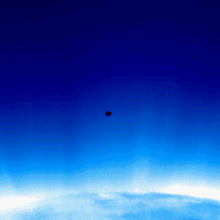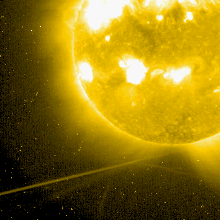|
Important notice about the deactivation of the STEREO ftp
server
Important notice about the STEREO redirects
Important notice about STEREO Behind
Welcome to the STEREO Learning Center
Image artifacts - Telescope and camera defects
Some artifacts are caused by defects in the cameras or optics used to take the
images. The most noticeable example of a camera defect is shown below. This
is a small fiber on the surface of the Charge-Coupled Device (CCD) camera for
the COR2 telescope on STEREO Ahead. The total length of the fiber is just 1
millimeter. It has been there since launch. Most likely this fiber came off
of one of the clean room wipes used during the assembly of the camera. Even
though the material of the wipes is selected to shed as few particles as
possible, the occasional particle does end up inside the instrument.
 |
| Close up image of a small fiber on the surface of the CCD
camera for COR2 on STEREO Ahead. Click on the image to see the location on the
detector.
|
The position of this fiber on the detector is fixed, and always shows up in the
same position in the raw images. However, the processed images on the website
include a correction for the spacecraft roll angle so that solar north always
points straight up. This causes the position of the fiber to change
over the course of the year, or whenever there's a spacecraft roll maneuver.
There are also several much smaller dust particles on the surface of the
various detectors. The image below shows a typical dust particle on the EUVI
detector on STEREO Behind, in this case just above the Sun's north pole.
 |
|
Small dust particle on the surface of the EUVI detector on STEREO Behind.
|
The movie below shows how spacecraft jitter affects dust particle images, this
time for the EUVI detector on STEREO Ahead. The left side of the movie shows
the images just as they appear on the detector, before any corrections are
applied. In these images, the triangular dust particle in the center does not
move, because it is adhered to the detector, but the solar images show
significant jitter. On the right side of the movie, the images have been
corrected for spacecraft jitter, causing the dust particle to appear to be
moving around, while the solar images remain steady.
Light leaks inside the EUVI telescope optics can also affect the images. EUVI
uses thin metal films to filter out direct sunlight and pass through only the
wavelengths of interest. Small holes can develop in these filters, letting
stray light through the system. To get around this problem, two sets of
filters are used, one at the front of the telescope, and another at the back,
to reduce the effect of light leaks. However, some faint leaks are still
visible in the images, as shown below for the 284 Angstrom bandpass on STEREO
Behind.
 |
|
Streaks caused by light leaks in the thin film filters for the 284 Angstrom
bandpass of EUVI on STEREO Behind. The contrast in the image have been
stretched to bring out the faint streaks.
|
See also the discussion about the
COR1 field lens
artifacts
in the background subtraction
section.
Back to image artifacts page.
Last Revised: Thursday, 09-Dec-2021 16:49:47 EST
Responsible NASA Official: ![[email address: therese.a.kucera<at>nasa<dot>gov]](/img/kucera_email.jpg)
Privacy Policy and Important Notices
Accessibility
Webmaster: Apexa Patel
|